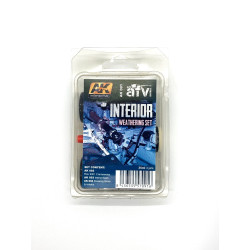There are a number of different options for attaching figures such as a horse and rider to a layout. Perhaps the...
No products
Product successfully added to your shopping cart
There are 0 items in your cart. There is 1 item in your cart.
Search Tips
What painting options do I have for weathering a model aircraft cockpit?
Once the cockpit sub-assembly has been completed and painted there are a number of techniques that can be made to weather it, allowing it to come to life. If the instrument panel is dominated by analogue switches and dials it will lend itself very well to dry brushing. Many instrument panels are matt black or another similar dark colour. As such dry brushing with a metallic colour such as aluminium can help individual switches and dials 'pop' and come to life. One added benefit of this process is that the instrument panel itself would be dulled by the dry-brushing process which would be effective at presenting a fading of colour over time.
Cockpit floors and access panels are often subject to wear such as scuffs and scratches in the paintwork. The random effects of scratches can be reproduced by tearing a small piece of sponge from a scouring pad and dipping it in a metallic colour such as Aluminium paint. Excess paint can be wiped on a piece of tissue to leave a fine residue on the sponge segment. If this is then applied to the model in areas of greatest wear and tear this technique can be very effective at mimicking scratches and scuffs.
A pin wash can be applied to vertical and horizontal stringers on the fuselage interior. This will help simulate oil and grime that accumulates in these areas over time. Likewise, this technique can be applied to a wide variety of locations where deposits would collect.
The last thing to consider will be the cockpit canopy itself. Clear parts may sometimes come with a thin film of residue from the manufacturing process and can also be dulled by fingerprint grease if parts are excessively handled. One way to help bring a real shine to these parts is to either brush or dip them in a solution of 'Clear' and let this then naturally evaporate away. This will add a real lustre to the part enabling an eye-catching polished glass finish.
Either used individually or in varying combinations these techniques can be used to add realism to a model aircraft cockpit and will really help make the detail 'pop', especially if the cockpit is to be modelled with the canopy open. Why not give them a try on your next project!
Click here to receive the tips weekly in your mailbox. You can unsubscribe at any time.










